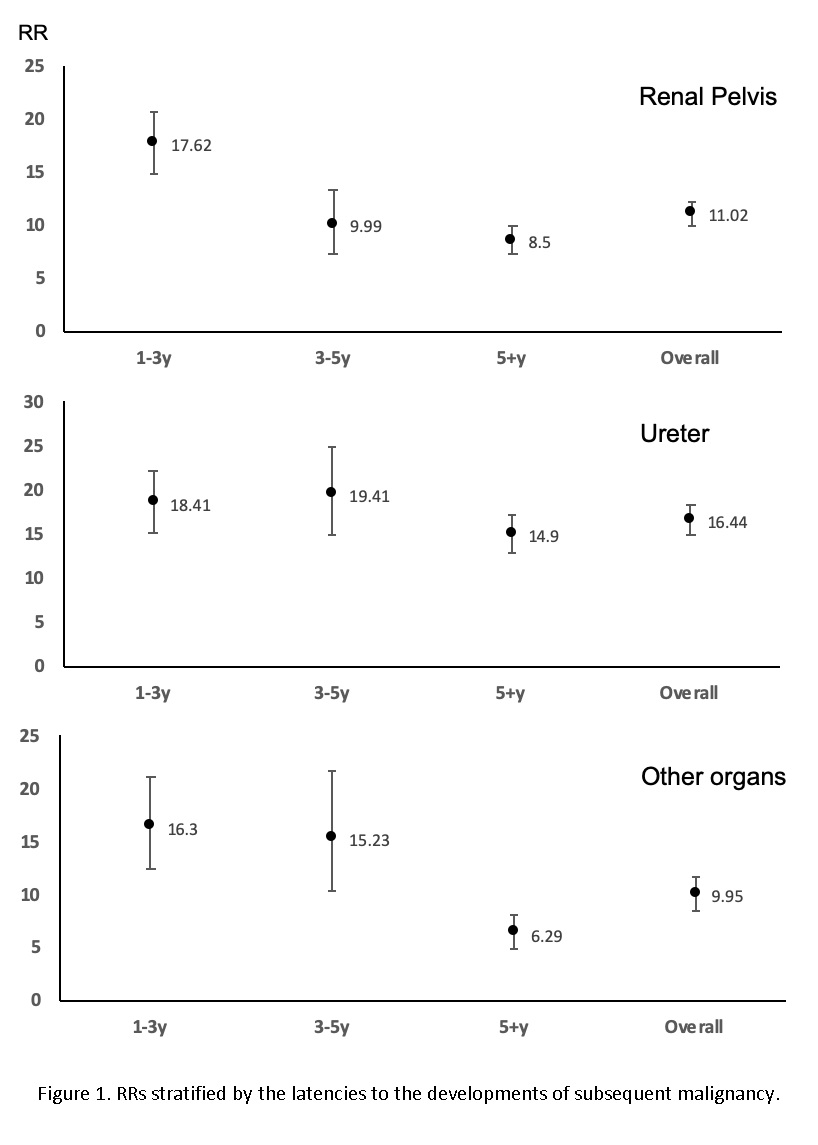Back
Poster, Podium & Video Sessions
Moderated Poster
MP42: Bladder Cancer: Epidemiology & Evaluation II
MP42-16: Various Incidence Risks of Subsequent Malignancies in Urinary Tract after Initial Bladder Cancer Diagnosis Stratified by Latencies
Sunday, May 15, 2022
10:30 AM – 11:45 AM
Location: Room 225
Shu Wang*, Ryan Russell, Michael Phelan, M. Minhaj Siddiqui, Baltimore, MD
Poster Presenter(s)
Introduction: Urinary tract malignancies after bladder cancer (BCa) diagnosis are uncommon, with reported rates of 1.3-13.7%. Early diagnosis and management during follow-up after the initial BCa event are critical. In this study, we aim to capture the incidence risks of subsequent malignancies (SMs) in the urinary tract after BCa diagnosis and investigate the magnitudes stratified by latencies to the development of SMs.
Methods: The Multiple Primary-Standardized Incidence Ratios (MP-SIR) session with SEER Research Plus data was used to search patients diagnosed with BCa as the first primary malignancy between 1975 to 2018. Patients who developed malignancies in the urinary tract at least 3 months after the diagnosis of BCa were considered “SMs”. The relative risks (RRs) of SMs were calculated by the number of observed events/number of expected events (based on U.S. mortality rates) and presented as mean+/-95%CI.
Results: 858 patients were identified, 78% (669/858) of which were males. The mean age of Bca diagnosis in this study cohort was 69.46 years, and mean latencies to the development of SMs in the renal pelvis, ureter, and other urinary organs (including urethra, paraurethral glands, and overlapping lesion of urinary organs) were 4.1 years, 3.81 years, and 4.9 years, respectively. The overall RRs of SMs in renal pelvis, ureter, and other urinary organs were 11.02 (95%CI 9.93-12.21), 16.44 (95%CI 14.82-18.18), and 9.95 (95%CI 8.41-11.69), respectively (all p<0.05). We calculated the RR ratios of (1-3years):(3-5years):(5+years) to compare RRs stratified by latencies to the development of SMs. RR ratios were 2.07:1.18:1, 1.24:1.30:1, and 2.59:2.42:1 for renal pelvis, ureter, and other urinary organs, respectively (Figure 1). The RR of SMs dropped dramatically 3 years afterward in the renal pelvis, 5 years in other urinary organs, and stayed high even after 5 years in ureter.
Conclusions: Following the initial diagnosis of BCa, the RRs of SMs vary in different urinary organs when stratified by latencies. This information could be used for follow-up strategy after initial BCa diagnosis and treatment.
Source of Funding: None.

Methods: The Multiple Primary-Standardized Incidence Ratios (MP-SIR) session with SEER Research Plus data was used to search patients diagnosed with BCa as the first primary malignancy between 1975 to 2018. Patients who developed malignancies in the urinary tract at least 3 months after the diagnosis of BCa were considered “SMs”. The relative risks (RRs) of SMs were calculated by the number of observed events/number of expected events (based on U.S. mortality rates) and presented as mean+/-95%CI.
Results: 858 patients were identified, 78% (669/858) of which were males. The mean age of Bca diagnosis in this study cohort was 69.46 years, and mean latencies to the development of SMs in the renal pelvis, ureter, and other urinary organs (including urethra, paraurethral glands, and overlapping lesion of urinary organs) were 4.1 years, 3.81 years, and 4.9 years, respectively. The overall RRs of SMs in renal pelvis, ureter, and other urinary organs were 11.02 (95%CI 9.93-12.21), 16.44 (95%CI 14.82-18.18), and 9.95 (95%CI 8.41-11.69), respectively (all p<0.05). We calculated the RR ratios of (1-3years):(3-5years):(5+years) to compare RRs stratified by latencies to the development of SMs. RR ratios were 2.07:1.18:1, 1.24:1.30:1, and 2.59:2.42:1 for renal pelvis, ureter, and other urinary organs, respectively (Figure 1). The RR of SMs dropped dramatically 3 years afterward in the renal pelvis, 5 years in other urinary organs, and stayed high even after 5 years in ureter.
Conclusions: Following the initial diagnosis of BCa, the RRs of SMs vary in different urinary organs when stratified by latencies. This information could be used for follow-up strategy after initial BCa diagnosis and treatment.
Source of Funding: None.


.jpg)
.jpg)
